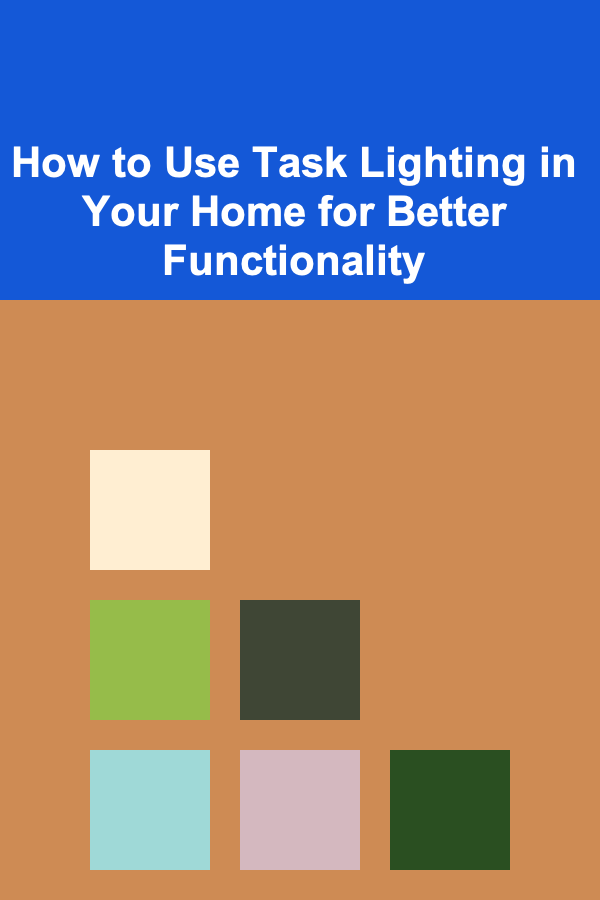
How to Use Task Lighting in Your Home for Better Functionality
ebook include PDF & Audio bundle (Micro Guide)
$12.99$8.99
Limited Time Offer! Order within the next:

Lighting is an essential element of any home design, not only for creating atmosphere but also for enhancing functionality. One of the most effective ways to optimize lighting in your home is by incorporating task lighting. Task lighting is designed to focus light on specific areas where you perform detailed activities, such as reading, cooking, working, or grooming. Unlike general ambient lighting, task lighting provides illumination that helps you complete tasks with greater ease and comfort, often reducing eye strain and increasing productivity.
In this article, we'll explore how you can use task lighting in various areas of your home to improve functionality. From the kitchen to the home office, we'll cover tips, types of task lighting, and best practices for integrating task lighting into your living spaces.
What is Task Lighting?
Task lighting refers to any lighting source that is intended to illuminate specific tasks or activities. The key to task lighting is precision---it's not about flooding a room with light but directing focused, bright light where you need it the most. Task lighting is typically brighter than ambient lighting, helping reduce shadows, enhance contrast, and improve visibility for tasks that require concentration.
Task lighting can be achieved through a variety of light sources, including:
- Desk lamps for reading or working
- Under-cabinet lighting in kitchens for food preparation
- Pendant lights over dining areas or workbenches
- Vanity lighting for bathrooms
- Adjustable floor lamps for reading or crafting
Proper task lighting can significantly improve the functionality of a space, creating an environment where you can work, read, cook, and carry out daily activities without strain or frustration.
Why is Task Lighting Important?
Good task lighting serves several important functions in your home:
1. Improves Comfort and Productivity
When lighting is directed toward specific tasks, it makes those activities more comfortable and efficient. Whether you're reading a book, cooking dinner, or working from home, good task lighting helps you focus on the task at hand without straining your eyes or being distracted by poorly lit spaces.
2. Reduces Eye Strain
A well-lit workspace can prevent eye fatigue, headaches, and discomfort. Task lighting helps avoid the need for your eyes to adjust constantly from dark to light, which often leads to eye strain. With sufficient lighting in the area where you perform tasks, you can work for longer periods without feeling discomfort.
3. Enhances Safety
Proper task lighting can also enhance safety, especially in areas like the kitchen, bathroom, and stairs. A well-lit environment allows you to carry out tasks safely by reducing the risk of accidents and injuries, such as burns in the kitchen or slipping in the bathroom.
4. Increases Visual Appeal
Task lighting can also serve a decorative purpose. By adding focused lighting in certain areas, you can highlight artwork, create focal points, and bring attention to architectural details or decorative elements in the home. This added layer of lighting creates visual interest while serving practical purposes.
Types of Task Lighting
Task lighting comes in various forms, each designed to suit different tasks and spaces. Here are some of the most common types of task lighting you can incorporate into your home:
1. Desk Lamps
Desk lamps are one of the most common forms of task lighting. They are perfect for illuminating workspaces such as desks, tables, or craft areas. Desk lamps come in a variety of styles, including adjustable models that allow you to direct light precisely where you need it.
- Best for: Home offices, study rooms, or any work area where you need to focus on reading, writing, or computer tasks.
- Features to look for: Adjustable brightness, adjustable arms or heads, and energy-efficient LED bulbs.
2. Under-Cabinet Lighting
Under-cabinet lighting is particularly useful in kitchens and bathrooms. Installed underneath cabinets, these lights brighten countertops, providing visibility for tasks such as food preparation, cleaning, and organizing.
- Best for: Kitchens, bathrooms, and work areas where countertop space is critical for various activities.
- Features to look for: LED strips or puck lights that can be easily installed, dimmable options, and a low-profile design.
3. Pendant Lights
Pendant lights are another versatile form of task lighting. They hang from the ceiling and are perfect for creating focused illumination over specific areas like dining tables, kitchen islands, or workbenches. These lights often come in various sizes, shapes, and designs, making them suitable for both functional and decorative purposes.
- Best for: Kitchen islands, dining areas, reading corners, and workspaces.
- Features to look for: Adjustable height, stylish design, and energy-efficient LED bulbs.
4. Track Lighting
Track lighting systems can be installed on the ceiling to provide focused light across a specific area. These systems consist of multiple lights attached to a single track, allowing you to adjust the direction of each light.
- Best for: Kitchens, galleries, or any space where you need adjustable lighting.
- Features to look for: Adjustable heads, compatibility with dimmer switches, and multi-bulb configurations for flexibility.
5. Floor Lamps
Floor lamps with adjustable heads or multiple light settings can be placed next to a couch or reading chair to provide task lighting for reading or hobbies. Their flexibility allows you to easily adjust the angle of the light, which can help illuminate specific areas.
- Best for: Living rooms, bedrooms, and reading nooks.
- Features to look for: Adjustable height and arm, dimmable features, and the ability to control light direction.
6. Wall-Mounted Lights
Wall-mounted task lights are a great way to add focused light to any area without taking up floor space. These lights can be installed near desks, reading chairs, or workstations to provide optimal task illumination without cluttering the room with floor lamps or table lamps.
- Best for: Bedrooms, bathrooms, and workspaces where you want to save on floor space.
- Features to look for: Adjustable arms, dimming capabilities, and sleek design to complement the room's decor.
How to Use Task Lighting in Your Home
Now that we've discussed the different types of task lighting, let's explore how to incorporate them into various spaces in your home.
1. In the Kitchen
The kitchen is a high-traffic area where effective task lighting can greatly improve functionality. Whether you're chopping vegetables, reading recipes, or washing dishes, you need well-lit workspaces to perform these activities safely and efficiently.
- Under-cabinet lighting: This is the most effective form of task lighting for kitchens. Install LED strips or puck lights underneath cabinets to illuminate countertops.
- Pendant lights over kitchen islands: If you have a kitchen island, hang pendant lights above it to provide focused light for cooking and meal prep.
- Recessed lighting: Use recessed lights in the ceiling above key areas such as the sink or stove to provide general task lighting that fills gaps.
2. In the Bathroom
The bathroom is another space where task lighting is essential. Whether you're applying makeup, shaving, or grooming, you need focused light that doesn't create shadows.
- Vanity lighting: Install vanity lights above the mirror or around the edges of the mirror to ensure even, shadow-free lighting. Consider adjustable wall-mounted lights for flexibility.
- Shower lighting: If your shower area requires lighting, choose waterproof, bright lights to ensure adequate visibility without causing discomfort.
3. In the Home Office
A well-lit home office is crucial for productivity and comfort, particularly for those who work from home or study regularly.
- Desk lamps: Use adjustable desk lamps to focus light on your work area. Position the lamp to avoid glare on your computer screen.
- Overhead track lighting: Install track lighting to illuminate the entire workspace. This will ensure you have an even distribution of light throughout your office.
4. In the Living Room
The living room is a multi-functional space where you may read, write, or engage in hobbies. Task lighting can help you set the right mood while also ensuring proper visibility for these activities.
- Floor lamps: Place adjustable floor lamps near your favorite reading spot to provide focused light without disturbing the overall atmosphere of the room.
- Table lamps: Use table lamps on side tables or desks to provide additional focused light for tasks like writing, drawing, or reading.
5. In the Bedroom
In the bedroom, task lighting can enhance functionality, particularly for bedtime reading or other nighttime activities.
- Bedside lamps: Install bedside lamps that allow you to adjust the light's brightness. These lamps can be placed on nightstands or mounted on the wall to free up space.
- Reading lights: If you prefer to read in bed, use clip-on reading lights or adjustable sconces that direct light onto your book without disturbing your partner.
Best Practices for Task Lighting
While task lighting can greatly improve functionality in your home, it's important to follow a few best practices to get the most out of it:
- Layer your lighting: Combine task lighting with ambient lighting (general room lighting) and accent lighting (decorative lighting) for a well-rounded lighting setup. This layering approach provides flexibility for different activities and moods.
- Consider light color temperature: For task lighting, opt for cool white or daylight bulbs, which provide a brighter, more focused light ideal for work or reading. Warm light, on the other hand, is better for relaxation.
- Choose dimmable lights: Dimmable task lighting allows you to adjust the light intensity based on the task at hand. It also helps conserve energy and creates a comfortable atmosphere.
Conclusion
Task lighting is a vital aspect of creating a functional and comfortable home environment. By strategically incorporating task lighting into your home, you can enhance visibility, productivity, and safety while also improving the aesthetics of each space. Whether you're cooking in the kitchen, working in your home office, or relaxing in the living room, task lighting ensures that you can perform any activity with ease and focus.
By understanding the types of task lighting available and applying them to the appropriate spaces in your home, you can create an environment that supports your daily activities and makes your home feel more functional and efficient.
Reading More From Our Other Websites
- [Organization Tip 101] How to Incorporate Plants into Your Study Room for Fresh Air
- [Organization Tip 101] How to Create a Family Budget That Works for Everyone
- [Organization Tip 101] How to Schedule Regular Tech Maintenance for Devices
- [Home Holiday Decoration 101] How to Organize and Store Your Holiday Decorations After the Season
- [Polymer Clay Modeling Tip 101] The Ultimate Guide to Sculpting Realistic Miniature Food with Polymer Clay
- [Home Storage Solution 101] How to Organize Your Laundry Room for Maximum Efficiency
- [Skydiving Tip 101] The Daredevils Behind the Numbers: Profiles of Skydiving Record Holders
- [Home Party Planning 101] How to Use Technology to Enhance Your Party Experience
- [Personal Care Tips 101] How to Use a Facial Scrub as Part of Your Nighttime Skincare Routine
- [Organization Tip 101] How to Choose the Right Rain Barrel Kit for Your Home's Needs

DIY Gift Ideas for Him, Her, and Everyone in Between
Read More
How to Choose the Right Home Rental Property for Your Budget
Read More
The Librarian's Playbook: Essential Skills for Cataloging, Research, and Outreach
Read More
How to Understand DAOs (Decentralized Autonomous Organizations) on Blockchain
Read More
Mastering Floor Scrubber Machines for Large Areas: A Comprehensive Guide
Read More
How to Use Virtual Backgrounds Professionally
Read MoreOther Products

DIY Gift Ideas for Him, Her, and Everyone in Between
Read More
How to Choose the Right Home Rental Property for Your Budget
Read More
The Librarian's Playbook: Essential Skills for Cataloging, Research, and Outreach
Read More
How to Understand DAOs (Decentralized Autonomous Organizations) on Blockchain
Read More
Mastering Floor Scrubber Machines for Large Areas: A Comprehensive Guide
Read More